
- Home
- Brand
- Art Nouveau (4)
- Bold Bloc Design (6)
- Camerden Forster (2)
- Erhard & Sohne (2)
- Grès De Charenton (2)
- Handcrafted (2)
- Handmade (7)
- Herve Lelong (6)
- Karlsbad (3)
- Kayserzinn (4)
- Makenier (3)
- Mundia (2)
- No Brand / Generic (11)
- Nsp (2)
- Rosenthal (2)
- Starling (6)
- Unknown (2)
- Villeroy & Boch (4)
- Vintage (4)
- Wilhelm Kagel (2)
- Other (3253)
- Features
- Gender
- Material
- Period
- Size
Antique Vintage Art New Brass Afghan Kuchi Lapis Lazuli Sleeve Bracelet
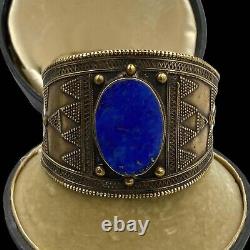
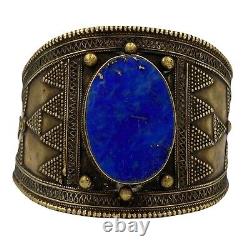
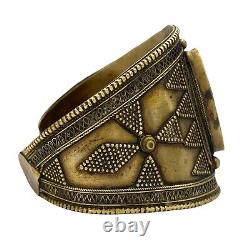
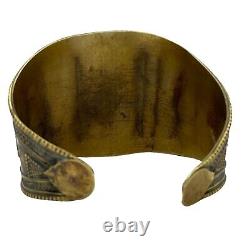
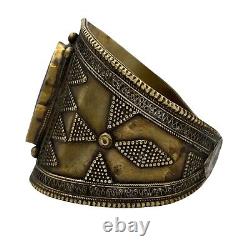
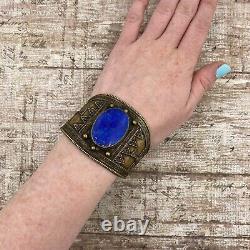


Antique vintage art new brass Afghan kuchi lapis lazuli cuff bracelet. This product sheet is originally written in English. Please find below a machine translation in French. If you have any questions please contact us. We have similar lapis of new and lazuli items, which would go well with this piece, on sale this week.
Object description by: angela a. Markings: unmarked, tested and guaranteed. Colour: dark blue colour opaque with shades of light blue marbled and golden speckled. Measurements/color of the accent stone. Stone treatment: the stone or stones seem not to have been treated, but we are not certified gemologists.The stones were tested and guaranteed using a professional refraction, heat and hardness tester presidium duo. Stone sizes: carved and polished cabochon. Portable length and inner circumference without counting the gap of the armband: 6.31.
The gap of the armband adds a supplement: 0.92. Total portable length and inner circumference: 7.23. Bracelet width: 0.52" to 1.97".
Type of closure / clasp: The bracelet is intended to be worn on the wrist through space. Link type: rounded and polished brass. Handcrafted at the time art nouveau in a style common to the nomad kushi people of Afghanistan. Probably bought as a souvenir during a large tour, the traditional party of the upper class at that time.
Composed of brass, which was shaped in a heavy cuff bracelet using the technique of working the repelled metal. Embellishing the face of the bracelet is a large stone of lapis-lazuli with a deep blue hue. The geometrical and twisted accents also accentuate the tapered broadband. Damage: wear adapted to age. The stone is a bit matte and can be polished by your local jeweller, if you wish.This list is for the article only. Not all photo displays and/or accessories are provided with your purchase. It was very true because of the beautiful designs that came out of this period. This time was centered on women, and the beauty of nature and the pieces were often voluminous.
The enamel was a standard material used in art nouveau jewellery, as the period was more focused on the importance of design than on the materials used to create it. The art nouveau period took place before the beginning of the First World War, when mass manufacturing took over the production of many products, including some jewellery.
Ancient Turkish, Islamic and Bedouin jewels all share similar ancestral and stylistic roots and have been mutually influenced by trade for many years. This can be largely attributed to the expansion of the Ottoman Empire, which valued art and crafts and promoted the pursuit of Arab arts and calligraphy. The reign of Ottomans in the xvie and xvii centuries introduced Turkish motifs into Islamic motifs and nomadic Bedouin culture, merging a range of styles into beautiful arabesques; repeating rhythmic motifs, which often include floral and organic geometric motifs.
Praised for its intense blue colour and unique golden spots, the lapis-lazuli has been extracted since about 7,000 BC. Some of the oldest and most beautiful lapis-lazuli mines are located in Afghanistan, particularly in the province of Badakhshan, where several mines are still in operation.
From the civilization of the valley of the indus to the ancient Egyptians and the artists of the medieval Europe, the lapis-lazuli was a very prized and sought after stone. Popular not only in jewellery, lapis-lazuli has also been reduced to powder by renaissance artists, who used it to create the expensive overseas blue pigment used in oil paintings. Throughout human history, lapis-lazuli has been carved and transformed into sandstone, jewellery and other decorative objects. Its rich blue pigment and its catchy golden spots make the stone very popular in ancient and modern jewels.
The repulse began as an old metalworking technique dating back to the 3rd century BC, involving a malleable metal that was hammered on the back to create an image on the front. Examples are found all over the world; the greek, the gypsy, and even the hopwell periods in the southeastern American. Inverse-side hammering has also been used to add details to the front, creating complex patterns with grooves, indentations and pipes. The piece was then carefully polished to create a hollow and catchy treasure. All items are shipped within one business day of receipt of payment. We do not underestimate packages for customs, please do not ask us to do so.What you pay is what we will ask on your customs form. Please take this into account before placing your bid. If you need more time to pay, please contact us before you bid. Throughout human history, lapis-lazuli has been carved and transformed into sandstone, jewellery and.
This item is in the category "Jewels, Watches\ Jewellery\Others". The seller is "abeautifultimeco" and is located in this country: us. This item can be shipped to the following country: whole world.-
Ancient: yes
- closure: none
- style: cuff button
- modified object: without
- vintage: yes Jewellery department: fine
- metal: copper
- country/region of manufacture: Afghanistan Type: bracelet Mark: - no mark/generic - Dominant stone: lapis lazuli

